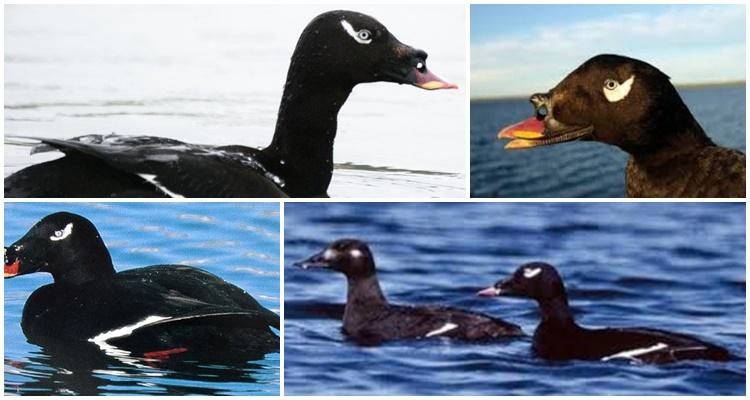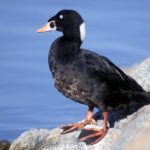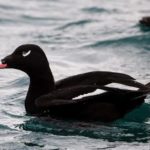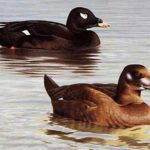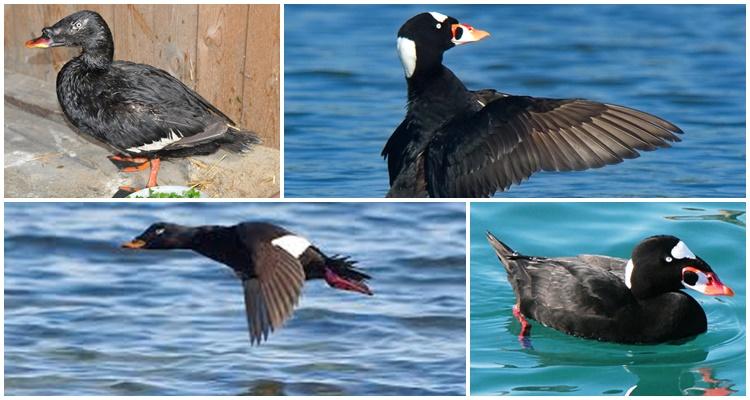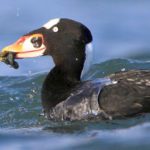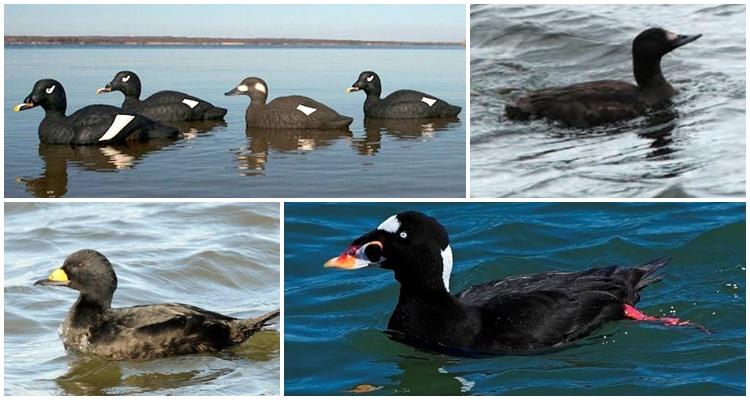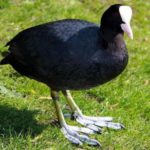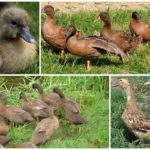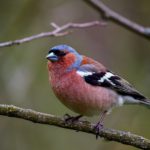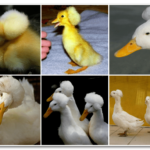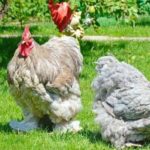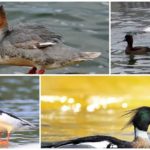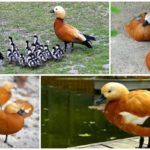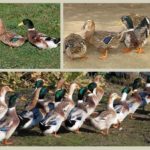In Eurasia, the northern regions of America and Africa, the scoter lives - a rare duck, the largest representative of wild ducks. Scoter scoters were once a popular commercial species, valued for their fatty meat and high-quality down, suitable for long-term use, which seriously affected their numbers. Today the species is protected by law, which should contribute to the restoration of the population.
Appearance of a scoter duck
The appearance of the scoter is mournful; ornithologists and hunters call the bird the sad duck. The body is large, dense and fleshy, the head is large, the neck is long.
External characteristics of males and females are given in the table.
| Parameter | Male | Female |
| eyes | pale gray in color, almost white, in combination with the dark colors of the feathers give the bird a mournful-sad look, white spots are visible under the eyes | grayish-blue, no white spots |
| beak | short, flattened, with large and noticeable nostrils, black from the edge to the nostrils, then orange with a black edging to the base, a pronounced hump at the base | longer, black-gray, without hump |
| paws | short, with thick bones, deep red color, located close to the tail, the membranes between the toes are wide | yellow-orange color, membranes less wide |
| color | deep black, with a bluish tint, white flight feathers on the sides form so-called “mirrors” | brown with speckles, flight feathers also form white “mirrors” |
| weight | up to 1.5 kg | up to 1.2 kg |
| body length | 52-58 cm | 50-55 cm |
| voice | an unpleasant squeaky quack, complemented by wheezing and hissing, sometimes similar to crows croaking and sighs with clicking sounds | burry, hoarse hissing quack |
The genus scoter is divided into several species, similar anatomically and in appearance, in general, fitting into the description indicated in the table. The species differ from the common scoter only in minor nuances of appearance and habitat:
- Humpbacked scoter. In males, the black plumage has an iridescent shimmer, with blue-violet and green shades visible. The white spots under the eyes are larger and extend to the back of the head. The name is due to the wider nostrils and convex hump. The original habitat is taiga lakes.
- Pied-billed scoter. A medium-sized duck, weighing about 1 kg. A distinctive feature of its appearance is the color of its beak: white spots and red patterns on a black base.The voice of the birds is a quiet quack with whistling. Habitats: lakes of Canada, northern USA, coniferous forests of Alaska.
- Singa (black scoter). The duck weighs a maximum of 1.3 kg. The beak is decorated with a yellow spot. The tail is long, with a sharp end. There are no white “mirrors” on the sides. In the cold season, both drakes and females are dark gray-brown. With the arrival of spring, males put on a mourning black outfit. The range covers Eurasia from the British to the Kuril Islands, stretches from Scandinavia in the north to the Mediterranean coast of Africa in the south.
Habitat and lifestyle
The scoter duck prefers to settle on lakes surrounded by mountains and coniferous forests. A significant part of the population leads a sedentary life in Georgian and Armenian reservoirs. They spend the winter in regions with a temperate climate; they fly away from the northern nesting grounds at the end of October and November. Departure begins later than for other wild waterfowl species, and the return to nesting grounds is noted in May, when northern reservoirs are freed from the ice cover.
The scoter duck nests in small bodies of water. During the migratory period, birds can be seen on rivers. Movement through the water is deft and swift, the duck swims with its chest out and head raised.
Bird character
Despite the gloomy plumage, the duck is calm, non-aggressive, and not inclined to conflict with other bird species. Turpans are careful and never approach human habitation.
The duck obtains food in the water, dives deftly, and can dive to a depth of 10 m and stay there for up to a minute. But scoters fly heavily, slowly, take off with effort from the water surface, and stay close to the earth's surface in flight.
What does it eat?
The main food of the scoter:
- small fish;
- shellfish;
- underwater vegetation;
- insects and larvae.
That is, the scoter duck is an omnivore, consuming both plant and animal foods. When hunting underwater, the duck swims remarkably well, rowing not only with wide-webbed paws, but also with outstretched wings. When the feeding area runs out of food, the scoters wander and fly to another feeding area.
Duck breeding
Duck pairs form in late winter or early spring. Birds arrive at nesting sites in pairs. If during the flight the females get separated from the flock, then the drakes slow down and wait for them. Group talk. To court females, males surround them. The drake dives underwater to quietly approach the chosen female. The next day, the fertilized duck circles low above the ground, quacks loudly, thereby signaling that it is about to lay eggs. The nest is insulated with its own down, so during the laying period it looks shabby.
The duck builds a nest right on the ground near the water. Often a scoter's nest can be seen in a colony of gulls. During the season, the duck makes one clutch - in the second half of June, and sits on it for about a month. The number of eggs varies among different types of scoters, but, on average, there are 7 of them. The eggs are oval, white or light beige. Hatched chicks are almost naked and weigh up to 55 g.
Due to the late laying, the ducklings are still very small by the beginning of August. Males do not stay with females for long; they fly away to the molting site.Due to the weak development of the maternal instinct, females also leave the young early and reunite with the males a few days after the chicks peck. And the young animals have to survive and feed on their own.
Many chicks die from hunger and predators; some manage to join the offspring of other waterfowl species.
At the end of October, the surviving young flock together in flocks, preparing to fly south. There are no old ducks in the flocks, since they flew to the molting site earlier. But young scoters are well oriented in flight and do not get lost on the way to their wintering place.
Lifespan
It is not easy for scoters to survive not only because of predators and other wildlife hazards, but also because of poaching. Few individuals survive to adulthood. Life expectancy is 13 years.
Conservation status
Turpans have long been hunted by the peoples of the north. The hunting season began in late May and June, when the birds that had returned to their homeland circled low over the reservoirs, preparing to nest in the chosen place.
The scoter is a cautious but stupid duck. It is not difficult for a hunter to lure her. So, northern miners bleated like lambs, and these sounds really attracted birds. Western hunters acted more cunningly: they made a stuffed scoter, took it to a pond, and the birds mistook the fake for a living relative. Among the northern peoples, it was customary to store killed carcasses directly on the icy surface of a reservoir, covered with moss.
Today, hunting for scoters is prohibited; the species is listed in the Red Book as endangered and in need of protection. The number of birds around the world does not exceed 4.5 thousand individuals. Although, thanks to the protected status, the number of individuals has stabilized, ornithologists hope that it will begin to increase.

